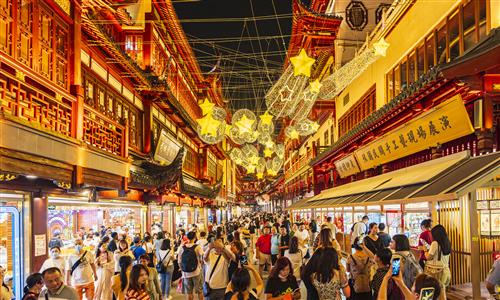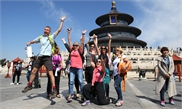Travel for National Day holidays expected to rise, boosting demand for relevant sectors amid policy support

People visit Jiaxiu Pavilion scenic area in Guiyang, capital of southwest China's Guizhou Province, Aug. 13, 2024. Guizhou Province, with its cool climate and rich tourism resources, attracts tourists from all over the country during the peak summer travel season. (Photo: Xinhua)
The rising demand for travel during China's week-long National Day holidays starting on October 1 is expected to inject more vitality into domestic consumption, with growth foreseen in relevant sectors amid ramped-up policy support.
Amid the peak season of "Golden September and Silver October," observers expect growth in tourism and related industries to fuel the nation's recovering consumption.
The transport sector is expected to handle 1.94 billion passenger trips nationwide during the holidays, with a daily average of 277 million trips. The daily average would be up 0.7 percent year-on-year and 19.4 percent compared with the same period in 2019, Vice Minister of Transport Li Yang said at a press conference on Friday.
Li highlighted a growing demand for domestic and international travel during the "golden week."
He noted that family tours and cross-provincial travel would be the mainstream options, with major destinations including such locations as Beijing, Shanghai and North China's Shanxi Province.
As of Saturday, searches for "travel during the National Day holidays" had surged 27 times year-on-year on domestic service apps Meituan and Dianping. Bookings for natural scenic spots accounted for 29.6 percent of the total orders and remained the top choice for family tours.
It is expected that the proportion of self-driving trips during the National Day holidays will exceed 80 percent, reaching 1.526 billion trips, Li said.
He also anticipated a rising demand for medium- and long-distance travel, as the average travel distance during the holidays is estimated to increase by about 30 percent compared with the three-day Mid-Autumn Festival break.
As for outbound travel, Li said that neighboring Southeast Asian countries are among the highly favored attractions.
Outbound flight and hotel bookings on Chinese online travel agency Qunar for the holiday covered nearly 1,600 cities in 144 countries and regions, the company said.
Holiday consumption will play a vital role in boosting GDP growth for the coming months, bolstered by growth in sectors such as tourism, catering, accommodation and transportation, said Wang Peng, an associate research fellow at the Beijing Academy of Social Sciences.
In the first eight months of 2024, retail sales rose by 3.4 percent year-on-year to 31.25 trillion yuan ($4.46 trillion), according to data from the National Bureau of Statistics (NBS). Online sales remained a bright spot, rising by 8.9 percent year-on-year to 9.63 trillion yuan.
In addition, the beautiful autumn weather will attract more travelers to opt for outdoor activities such as bike riding, leading to an increase in sales and production of corresponding equipment and tools, Jiang Yiyi, a vice dean of the School of Leisure Sports and Tourism at Beijing Sport University, told the Global Times on Saturday.
Jiang noted that support measures adopted by Chinese localities and responsible authorities - such as distributing vouchers and optimizing service quality in scenic spots - have significantly stimulated tourism.
Wang said that the implementation of dedicated measures to stimulate consumption represented by the trade-in program has been showing an effect while promoting consumption upgrading.
However, NBS spokesperson Liu Aihua said at a separate press conference in September that the consumption recovery still faces constraints, prompting authorities to channel even more energy into strengthening consumer sentiment and stimulating domestic demand.
The presence of improved government policies, combined with better products and services on the market, means that the potential of consumption will be unleashed at a faster pace and thus the consumer market will have a more solid foundation for recovery, Liu noted.



